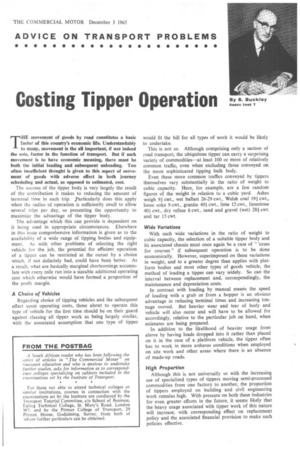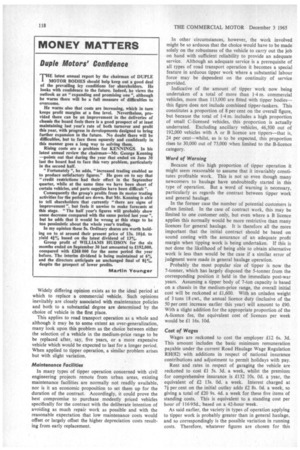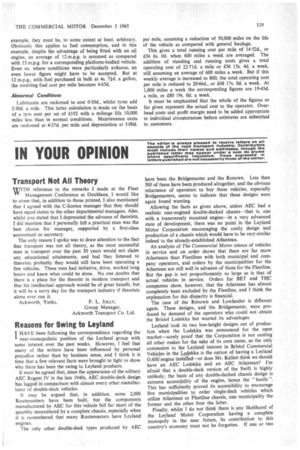Costing Tipper Operation
Page 119

Page 120

Page 121

If you've noticed an error in this article please click here to report it so we can fix it.
THE movement of goods by road constitutes a basic factor of this country's economic life. Understandably to marry, movement is the all important, if not indeed the sole, factor in the function of transport. But if such movement is to have economic meaning, there must be both the initial loading and subsequent unloading. Too often insufficient thought is given to this aspect of movement of goods with adverse effect in both journey scheduling and actual, as opposed to estimated, cost.
The success of the tipper body is very largely the result of the contribution it makes to reducing the amount of terminal time in each trip. particularly does this apply when the radius of operation is sufficiently small to allow several trips per day, so presenting the opportunity to maximize the advantage of the tipper body.
The advantage which this can provide is dependent on it being used in appropriate circumstances. Elsewhere in this issue comprehensive information is given as to the availability of a wide range of tipping bodies and equipment. As with other problems of selecting the right vehicle for the job, the potential for efficient operation of a tipper can be restricted at the outset by a choice which, if not definitely bad, could have been better. As a result, what are basically marginal shortcomings accumulate with every mile run into a sizeable additional operating cost which otherwise would have formed a proportion of the profit margin.
A Choice of Vehicles Regarding choice of tipping vehicles and the subsequent effect upon operating costs, those about to operate this type of vehicle for the first time should be on their guard against classing all tipper work as being largely similar, with the associated assumption that one type of tipper would fit the bill for all types of work it would be likely to undertake.
This is not so. Although comprising only a section of road transport, the ubiquitous tipper can carry a surprising variety of commodities—at least 100 or more of relatively common traffic, even when excluding those conveyed on the more sophisticated tipping bulk body.
Even these more common traffics conveyed by tippers themselves vary substantially in the ratio of weight to cubic capacity. Here, for example, are a few random figures of the weight in relation to a cubic yard. Ashes weigh 9/ cwt., wet ballast 26-29 cwt., Welsh coal 191 cwt, loose coke 9 cwt., granite 401 cwt., lime 12 cwt,, limestone 401 cwt., dry refuse 6 cwt., sand and gravel (wet) 281 cwt. and tar 15 cwt.
Wide Variations With such wide variations in the ratio of weight to cubic capacity, the selection of a suitable tipper body and its associated chassis must once again be a case of " 'orses for courses" if subsequent operation is to be done economically. However, superimposed on these variations in weight, and to a greater degree than applies with platform bodies and most other types of goods vehicle, the method of loading a tipper can vary widely. So can the interval between replacement and, correspondingly, the maintenance and depreciation costs.
In contrast with loading by manual means the speed of loading with a grab or from a hopper is an obvious advantage in reducing terminal times and increasing tonnage moved. But heavier wear and tear of body and vehicle will also occur and will have to be allowed for accordingly, relative to the particular job on hand, when estimates are being prepared.
In addition to the likelihood of heavier usage from above by having loads dropped into it rather than placed on it in the case of a platform vehicle, the tipper often has to work in more arduous conditions when employed on site work and other areas where there is an absence of made-up roads.
High Proportion
Although this is not universally so with the increasing use of specialized types of tippers moving semi-processed commodities from one factory to another, the proportion of tippers employed on building and civil engineering work remains high. With pressure on both these industries for even greater efforts in the future, it seems likely that the heavy usage associated with tipper work of this nature will increase, with corresponding effect on replacement policy and the associated financial provision to make such policies effective. Widely differing opinion exists as to the ideal period at which to replace a commercial vehicle. Such opinions inevitably are closely associated with maintenance policies and both to a substantial degree are determined by the choice of vehicle in the first place.
This applies to road transport operation as a whole and although it may be to some extent an over-generalization, many look upon this problem as the choice between either the selection of a vehicle in the medium-price range to be be replaced after, say, five years, or a more expensive vehicle which would be expected to last for a longer period. When applied to tipper operation, a similar problem arises but with slight variation.
Maintenance Facilities In many types of tipper operation concerned with civil engineering projects remote from urban areas, existing maintenance facilities are normally not readily available, nor is it an economic proposition to set them up for the duration of the contract. Accordingly, it could prove the best compromise to purchase modestly priced vehicles specifically for the contract with the deliberate intention of avoiding as much repair work as possible and with the reasonable expectation that low maintenance costs would offset or largely offset the higher depreciation costs resulting from early replacement. In other circumstances, however, the work involved might be so arduous that the choice would have to be made solely on the robustness of the vehicle to carry out the job on hand with sufficient reliability to provide an adequate service. Although an adequate service is a prerequisite of all types of road transport operation it becomes a special feature in arduous tipper work where a substantial labour force may be dependent on the continuity of service provided.
Indicative of the amount of tipper work now being undertaken of a total of more than 1-4 in. commercial vehicles, more than 113,000 are fitted with tipper bodies— this figure does not include combined tipper-tankers. This constitutes a proportion of 8 per cent on the overall figure, but because the total of 14m. includes a high proportion of small C-licensed vehicles, this proportion is actually underrated. Excluding ancillary vehicles, 46,500 out of 192,000 vehicles with A or B licence are tippers—that is, 24 per cent—whilst, as is to be expected, this proportion rises to 30,000 out of 73,000 when limited to the B-licence category.
Word of Warning
Because of this high proportion of tipper operation it might seem reasonable to assume that it invariably constitutes profitable work. This is not so even though many newcomers to haulage have undoubtedly started in this type of operation. But a word of warning is necessary, particularly as regards the contrast between tipper work and general haulage.
In the former case the number of potential customers is often limited. In the case of contract work, this may be limited to one customer only, but even where a B licence applies this normally would be more restrictive than many licences for general haulage. It is therefore all the more important that the initial contract should be based on sound costing with the assurance of an adequate profit margin when tipping work is being undertaken. If this is not done the likelihood of being able to obtain alternative work is less than would be the case if a similar error of judgment were made in general haulage operation.
Probably, the most popular size of tipper is now the 7-tonner, which has largely disposed the 5-tonner from the corresponding position it held in the immediate post-war years. Assuming a tipper body of 7-ton capacity is based on a chassis in the medium-price range, the overall initial cost will be reckoned at £1,600. With an unladen weight of 3 tons 18 cwt., the annual licence duty (inclusive of the 50 per cent increase earlier this year) will amount to £90. With a slight addition for the appropriate proportion of the A-licence fee, the equivalent cost of licences per week would be £1 16s. 10d.
Cost of Wages
Wages are reckoned to cost the employer £12 6s. 3d. This amount includes the basic minimum remuneration payable under the current Road Haulage Wage Regulation RH(82) with additions in respect of national insurance contributions and adjustment to permit holidays with pay.
Rent and rates in respect of garaging the vehicle are reckoned to cost Ll 5s. 3d. a week, whilst the premium for comprehensive insurance is £132 10s. Od. a year, the equivalent of £2 13s. Od. a week. Interest charged at 74 per cent on the initial outlay adds £2 8s. Od. a week, so giving a total of £20 9s. 4d. a week for these five items of standing costs. This is equivalent to a standing cost per hour of 116.95d., based on a 42-hour week.
As said earlier, the variety in types of operation applying to tipper work is probably greater than in general haulage, and so correspondingly is the possible variation in running costs. Therefore, whatever figures are chosen for this example, they must be, to some extent at least, arbitrary. Obviously this applies to fuel consumption, and in this example, despite the advantage of being fitted with an oil engine, an average of 12 m.p.g. is assumed as compared with 15 m.p.g. for a corresponding platform-bodied vehicle. Even so, where conditions were particularly arduous, an even lower figure might have to be accepted. But at 12 m.p.g., with fuel purchased in bulk at 4s. 73d. a gallon, the resulting fuel cost Per mile becomes 4.65d.
Abnormal Conditions
Lubricants are reckoned to cost 0.30d., whilst tyres add 2.30d, a mile. This latter calculation is made on the basis of a tyre cost per set of £192 with a mileage life 10,000 miles less than in normal conditions. Maintenance costs are reckoned at 4.27d. per mile and depreciation at 3.00d. per mile, assuming a reduction of 50,000 miles on the life of the vehicle as compared with general haulage.
This gives a total running cost per mile of 14.52d., or £36 6s. Od. when 600 miles a week are averaged. The addition of standing and running costs gives a total operating cost of 22.71d. a mile or £56 15s. 4d. a week, still assuming an average of 600 miles a week. But if this weekly average is increased to 800, the total operating cost per mile is reduced to 20.66d., or £68 17s. Od. a week. At 1,000 miles a week the corresponding figures are 19.43d. a mile, or £80 19s. Od. a week.
It must be emphasized that the whole of the figures so far given represent the actual cost to the operator. Overhead costs and profit margin need to be added appropriate to individual circumstances before estimates are submitted to customers.
















































































































































































